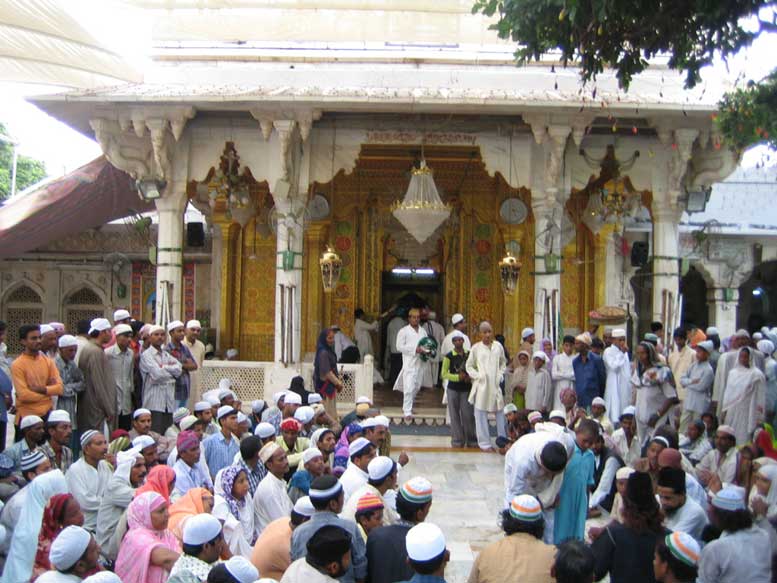ZiyÄrah or ZeyÄrat (Arabic: زيارة‎; the form ziyÄrat is commonly used when it is translated into other languages) is an Arabic term which literally means "visit", and is used to refer to a form of pilgrimage to sites associated with Muhammad (his family members and descendants (including the Shī‘ī ImÄms), his companions) and other venerated figures in Islam (such as the prophets, Sufi saints and Islamic scholars). Sites of pilgrimage include mosques, graves, battlefields, mountains, and caves.
ZiyÄrat can also refer to a form of supplication made by the Shia, in which they send salutations and greetings to Muhammad and his family.
Pilgrimage sites

Different Muslim-majority countries, speaking many different languages, use different words for these sites where ziyarat is performed.
- Ziyãratgãh â€" Persian word meaning, "sites of Ziyarat"
- Imãmzãdeh â€" in Iran, tombs of the descendants of the Twelver ImÄms
- Dargah (Urdu/Persian: درگاÛ;‎ Hindi: दरगाह; literally: "threshold, doorstep [of the interred holy person's spiritual sanctum];" the shrine is considered a "doorstep" to a spiritual realm) â€" in South Asia, and Central Asia for tombs of Sufi saints
- Ziarat or Jiarat â€" in Southeast Asia
- Ziyaratkhana â€" in South Asia (less common)
- DargÄh (Turkish: Dergâh, ziyaretgâh or türbe) â€" in Turkey
- Gongbei (Chinese: 拱北 â€" in China (from Persian gonbad "dome")
- 'Mazar: a general term meaning a shrine, typically of a Shi'i saint or noble.
Etymology and usage

Sufi places of worship and retreat may be built near the graves of famous Sufi saints; they are often called khanqahs or tekkes. Ziyarat" comes from Arabic: زور‎ "to visit". Iranian and south-Asian Muslims use the word ziyarat for both the Hajj pilgrimage to Mecca as well as for pilgrimages to other sites such as visiting a holy place. In Indonesia the term is ziarah for visiting holy places or graves.
Views on Ziyarat

Sunni views
Sunni scholars declare that the purpose of visiting the graves and cemeteries is only to remind people of death and a curse be upon the Jews and Christians for taking the graves of their Prophets as places of worship.
Narrated By 'Aisha : Umm Salama told Allah's Apostle about a church which she had seen in Ethiopia and which was called Mariya. She told him about the pictures which she had seen in it. God's Apostle said, "If any righteous pious man dies among them, they would build a place of worship at his grave and make these pictures in it; they are the worst creatures in the sight of God."
The most evil of mankind are those who will be alive when the Last Day arrives and those who take graves as places of worship.â€
It is also reported in the most authentic books of Sunni Islam that Aa’ishah (wife of Muhammad) reported:
Had it not been so, his (i.e. the Prophet’s) grave would have been in an open place, but it could not be due to the fear that it could be taken as a mosque.
- “...Beware that those before you took the graves of their Prophets as places of worship. Do not take graves as places of worship, for verily I forbid you to do so.â€
- “The most evil of mankind are those who will be alive when the Last Day arrives and those who take graves as places of worship.â€
Sufi views
The purpose of visiting a grave is to gain llim (divine knowledge), tafakkur and to pray for the person in the grave, but if the person in the grave is a Prophet or an Awliya (friend of God), fayd and spiritual benefits can be gained from their souls. The person who is visited, must be thought of as if he is alive and must be visited with the same good manners.
Shī‘ah views
There are many reasons for which the Shī‘ah partake in the performance of Ziyarah, none of which include the worship of the people buried within the tombs - Ayatullah Borujerdi and Ayatullah Khomeini have both said
The Shī‘ah do however perform Ziyarah, believing that the entombed figures bear great status in the eyes of God, and seek to have their prayers answered through these people (a form of Tawassul) - Sayyid Muhammad Hasan Musawi writes
In this regard, Ibn Shu’ba al-Harrani also narrates a hadÄ«th from the tenth ImÄm of the Twelver Shī‘as
The Ziyarah of the ImÄms is also done by the Shī‘ah, not only as a means of greeting and saluting their masters who lived long before they were born, but also as a means of seeking nearness to God and more of His blessings (barakah).
The Shī‘ah do not consider the narrations in Bukhari to be authentic, and argue that if things such as Ziyarah and Tawassul were innovations and shirk, Muhammad himself would have prohibited people as a precaution, from visiting graves, or seeking blessings through kissing the sacred black stone at the Ka‘bah. Some Sunni scholars such as Ibn Taymiyyah, have also rejected the notion that such things are innovations (bid'ah).
It is popular Shi'i belief that to be buried near the burial place of the Imams is beneficial. In Shi'i sacred texts it is stated that the time between death and resurrection (barzakh, purgatory) should be spent near the Imams.
See also

- Hajj
- Imamzadeh
- List of ziyarat locations
- Tablet of Visitation
References
_Route_map.jpg/514px-Ziyarat_Express_(Ajmer_-_Rajendranagar)_Route_map.jpg)
Further reading

- Privratsky, Bruce G.(2001) Muslim Turkistan: Kazak Religion and Collective Memory. Richmond, Surrey: Curzon.
- Subtelny, M. E. (1989) The cult of holy places: religious practices among Soviet Muslims. Middle East Journal, 43(4): 593â€"604.
External links
.jpg)
- Ziyarat of Imam Husain
- AL-ARIFEEN for FAQRISM (Spiritualism & Mysticism)
- AL-FAQR for FAQRISM (Spiritualism & Mysticism)
- Views held by The Shia on Ziyarat
- Archnet shrine directory, with pictures
- Madurai Hazrats'Maqbara
- Book: Your Personal Guide to UMRA, HAJJ, and ZIYARAT (pdf file)
- Listing of ziyarat sites
.jpg/450px-Ziarat_Shareef_(2).jpg)
